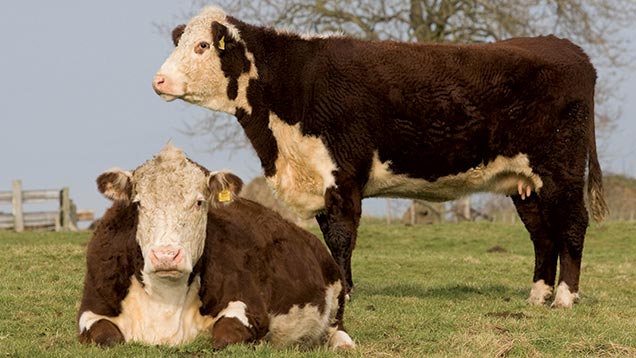Survey shows large fall in Charolais and Hereford suckler cows
 ©Tim Scrivener
©Tim Scrivener A greater focus on terminal sire traits could have implications for the UK’s suckler beef industry over the next decade, compromising maternal traits like calving ease.
An Eblex-funded study looking at the breed makeup of the British suckler herd has shown significant falls in three numerically important breeds.
Charolais and Hereford cow numbers have fallen by around 30% over the last 10 years while the Simmental has experienced a 15% fall.
See also: Easy calving makes Saler breed a popular suckler choice
Eblex breeding specialist Samuel Boon, who led the study, believes a factor could be more beef producers breeding their own female replacements instead of relying on cross-bred heifers produced by the dairy industry – a traditional role for the Hereford breed.
This approach has advantages, but it does mean producers will need to give more consideration to the use of breeds and breeding lines with strong maternal traits and good milk production.
“It is a question of how much terminal sire breeding do you want in your maternal suckler cow and, where terminal sire breeds are being used within the crossing programme; do they have the right maternal traits?” says Mr Boon.
“Most terminal sire breeds are making tremendous genetic improvement in terms of growth rate and carcass conformation, but traits influencing calving ease are either not improving or getting worse. Traits like milkiness are relatively unselected.”
Popularity stakes
Winners – Aberdeen Angus and Limousin, which remains the most popular breed. Stabiliser has shown the fastest growth over the last 10 years while some native breeds have also recorded increases including Beef Shorthorns, Luing and Sussex.
Losers – Charolais, Hereford and Simmental.
Mr Boon urges caution. “Calving ease could be a challenge in the future if we breed highly muscular cows and ignore breeding values for birth weight and calving ease when selecting bulls. A calf’s genetics are worthless if it is born dead.”
Reproductive traits and longevity could be affected also. Although breeding values are available to bull breeders and buyers, they are not widely used for decision-making in most terminal sire breeds.
A challenge in selecting for maternal traits is that the EBVs for young bulls are often associated with low accuracy values. In the future, the use of genomic technology to look directly at the variation in a bull’s DNA may help to lift accuracy.
The study analysed data provided by the British Cattle Movement Service on the breed of the mothers of calves registered on the BCMS database.
It indicates that breed-based marketing schemes are having an influence on breed use.
“Both the Aberdeen Angus and the Beef Shorthorn breeds are increasing in number; both breeds are awarded a retailer-driven premium in the market place,” says Mr Boon.
Aberdeen Angus genetics have in fact overtaken the Simmental to be the mostly widely recorded breed of cow after the Limousin which, at 352,489 breeding cows/year, remains the dominant breed used to produce suckler cows.
Amongst the numerically smaller breeds, the Stabiliser has shown the fastest growth over the last 10 years – from a small base of 1,028 cows to 10,980 in 2014 – a rise of 968%. Some of the native breeds have also recorded increases – there are 42% more Beef Shorthorns with similar rises in the Luing and Sussex breeds.
There could be several reasons for these rises, Mr Boon suggests. “They go some way to solving the “what is the ideal cow for my system” conundrum in that they are lower maintenance with a medium frame size and the ability to thrive on low cost inputs. I am not surprised to see them holding their own.”
Different systems need different solutions – there is no “one size fits all”. In some suckler herds, where feed supplies are plentiful and relatively cheap, an increase in cow mature size is rewarded, with costs offset by higher cull cow values.
However, Mr Boon says the beef industry must realise that placing an increasing emphasis on high growth genetics will result in progressively bigger suckler cows, unless mature size is taken into consideration.
Some breed societies are actively taking steps to protect and enhance maternal attributes, such as the Limousin breed, whose 10-year breeding improvement plan sets out to encourage more emphasis on longevity, fertility and milk production.
“In many cases it may be less about changing the whole breed and more about concentrating on identifying different strains within the breed that are suitable for breeding productive female replacements,” says Mr Boon.
As suckler producers look to the future, he advises them to not underestimate the importance of hybrid vigour.
“Often by introducing another breed into the programme there are benefits in longevity, fertility and resistance to disease challenges.”
He also believes there could benefits from greater co-operation between the dairy farmer and the suckler producer to use selected beef sires with superior maternal characteristics to produce beef-cross dairy-bred suckler replacements.
